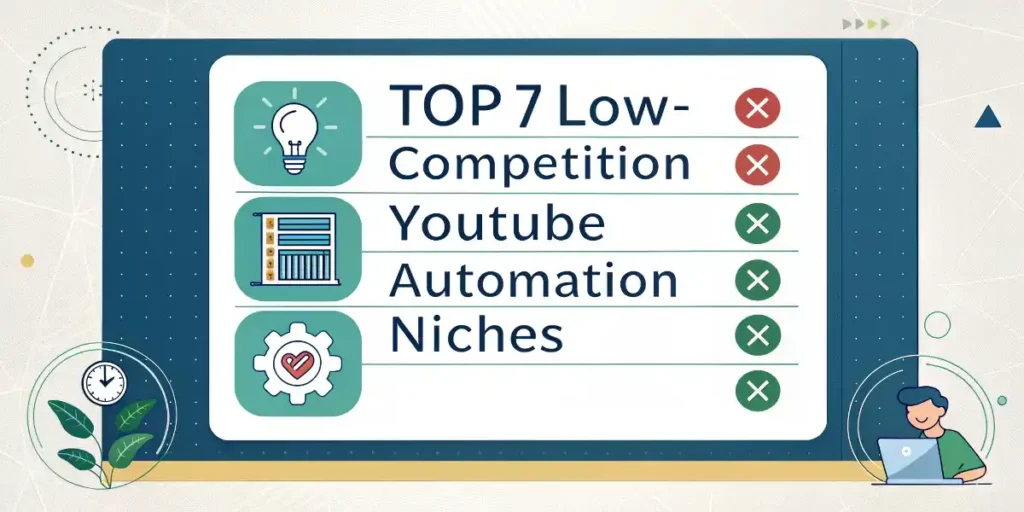Think of it like real estate. You want decent foot traffic but not Times Square prices.
How to Identify Profitable Low-Competition Niches
Using YouTube Analytics Tools
VidIQ and TubeBuddy are your weapons of choice.
Here’s my exact process:
- Enter broad keywords in VidIQ’s keyword research
- Filter for search volume: 5 K- 50 K monthly
- Look for competition scores under 40
- Check if the top videos have under 100K views
Pro tip: If the #1 video for your keyword has under 50K views, you’ve found gold.
Competitor Gap Analysis
Study your potential competitors like a detective.
Look at their upload frequency. If they’re posting once a month, you can dominate with weekly content.
Check their engagement rates. Comments per view under 0.5%? That audience is hungry for better content.
According to Backlinko’s analysis, channels posting 3x more frequently than competitors see 284% faster growth.
Search Volume vs Competition Metrics
Most creators get this backwards. They chase high search volume and ignore competition.
Smart creators target the inverse:
| Niche Type | Search Volume | Competition | Success Rate |
| High Competition | 500K+ | 80+ | 5% |
| Medium Competition | 100K-500K | 50-80 | 25% |
| Sweet Spot | 10K-100K | 20-50 | 70% |
| Low Competition | Under 10K | Under 20 | 40% |
The sweet spot gives you the best risk-to-reward ratio.
Top 7 Low-Competition YouTube Automation Niches

Personal Finance for Beginners
Average monthly searches: 45K
Competition score: 28
Revenue potential: $3K-15K monthly
This niche exploded post-2020. People want basic money advice without intimidating jargon.
Content angles that work:
- “How to save $1000 in 30 days”
- “Credit score hacks for beginners”
- “Side hustles that actually work”
Monetization streams: Course sales, affiliate marketing, and financial app partnerships.
DIY Home Organization Hacks
Average monthly searches: 38K
Competition score: 22
Revenue potential: $2K-8K monthly
Everyone’s obsessed with organizing their space. The pandemic made this explode.
Winning content formats:
- Before/after transformations
- Budget organization challenges
- Room-specific solutions
Revenue comes from Amazon affiliate links, organization product partnerships, and digital planners.
Pet Training and Care Tips
Average monthly searches: 52K
Competition score: 35
Revenue potential: $4K-12K monthly
Pet owners spend $261 billion annually on their animals. They’ll pay for good advice.
Content that crushes:
- Breed-specific training guides
- Common behavior problems solved
- DIY pet care tutorials
Multiple monetization paths: Pet product affiliates, training courses, vet partnerships.
Study Tips and Productivity
Average monthly searches: 41K
Competition score: 29
Revenue potential: $2K-10K monthly
Students and professionals constantly seek productivity improvements.
High-performing content:
- Study method comparisons
- Productivity app reviews
- Time management systems
Revenue sources: Course creation, app affiliates, productivity tool partnerships.
Local Travel and Hidden Gems
Average monthly searches: 33K
Competition score: 18
Revenue potential: $3K-9K monthly
People want authentic travel experiences, not tourist traps.
Winning angles:
- “Hidden gems in [City]”
- Budget travel guides
- Local food discoveries
Monetization: Travel affiliate programs, local business partnerships, travel gear reviews.
Cooking for Small Households
Average monthly searches: 29K
Competition score: 25
Revenue potential: $2K-7K monthly
Single people and couples struggle with recipes designed for families.
Content that works:
- Meal prep for one
- Quick weeknight dinners
- Budget grocery shopping
Revenue streams: Kitchen affiliate links, meal planning apps, and cookbook sales.
Budget Fitness and Wellness
Average monthly searches: 47K
Competition score: 31
Revenue potential: $3K-11K monthly
Expensive gym memberships pushed people toward home fitness solutions.
Popular content:
- No-equipment workouts
- Healthy meals under $5
- Mental health tips
Monetization: Fitness affiliate programs, supplement partnerships, workout guides.
Also Read : Top YouTube Automation Niches in 2025: Blueprint to Passive Income
Content Creation Strategies for Each Niche

Evergreen Content Frameworks
Create content that stays relevant for years.
The “How-to” framework works across all niches:
- Hook with the problem
- Promise the solution
- Deliver step-by-step process
- Show results/proof
- Call to action
CoSchedule research shows that evergreen content generates 38% more views over time than trending content.
Trending Topic Integration
Mix evergreen with trending for maximum reach.
Leverage Google Trends to identify emerging topics within your niche. Create content that ties trending topics to your evergreen themes.
Example: “New Year Budget Planning Using TikTok’s Viral 100 Envelope Challenge”
Series and Playlist Development
YouTube’s algorithm loves series content.
Plan 5-10 video series around core topics:
- “Beginner’s Guide to [Topic]”
- “30-Day [Skill] Challenge”
- “[Number] Ways to [Solve Problem]”
Series keep viewers on your channel longer, boosting watch time and rankings.
Automation Tools and Techniques
Content Planning and Scheduling
Batch content creation saves massive time.
My automation stack:
- Notion: Content calendar and planning
- Later: Social media scheduling
- Loom: Quick video instructions for the team
- Canva: Template creation for thumbnails
Plan 30 days of content in one session. Your future self will thank you.
Thumbnail and Title Optimization
Templates are your secret weapon.
Create 5-10 thumbnail templates in Canva. Your VA can pump out thumbnails in minutes.
Title formulas that work:
- “How to [Achieve Desire] in [Timeframe]”
- “[Number] [Thing] That [Benefit]”
- “Why [Common Belief] is Wrong”
Backlinko’s study found that custom thumbnails increase click-through rates by 154%.
Comment Management and Engagement
Automate responses without losing authenticity.
Use TubeBuddy’s canned responses for common questions. Create templates for:
- Thank you messages
- FAQ answers
- Call-to-action responses
Respond within 2 hours for maximum engagement boost.
Monetization Strategies for Low-Competition Niches

AdSense Revenue Optimization
Low-competition niches often have higher RPMs (revenue per mille).
Financial content: $3-8 RPM
Home organization: $1-4 RPM
Pet training: $2-5 RPM
Optimize for watch time over views. YouTube’s Creator Insider confirms that longer videos earn more ad revenue.
Affiliate Marketing Opportunities
Every niche has affiliate potential.
High-converting affiliate categories:
- Finance: Credit monitoring, budgeting apps
- Organization: Storage solutions, planning tools
- Pets: Food, toys, training equipment
- Fitness: Equipment, supplements, apps
Amazon Associates typically earns 1-3% commission. Direct partnerships can hit 10-50%.
Sponsorship and Brand Partnerships
Brands pay premium rates for engaged, niche audiences.
Pitch sponsors with these metrics:
- Engagement rate (aim for 3%+)
- Audience demographics
- Previous campaign results
- Content alignment examples
Micro-influencers (10 K- 100 K subscribers) often earn more per subscriber than mega-influencers.
Scaling Your YouTube Automation Business
Multi-Channel Strategy
One successful channel becomes your template for 10 more.
Document everything:
- Content creation process
- Upload schedules
- Optimization techniques
- Team responsibilities
According to Think Media, creators with multiple channels earn 340% more than single-channel creators.
Team Building and Outsourcing
Your first hires should be:
- Script writer ($10-25 per script)
- Video editor ($25-100 per video)
- Thumbnail designer ($5-15 per thumbnail)
- Virtual assistant ($5-15 per hour)
Use Upwork, Fiverr, or specialized platforms like Voice123 for talent.
Long-term Growth Planning
Think systems, not channels.
Year 1: Master one niche, one channel.
Year 2: Expand to 3-5 channels in the same niche.
Year 3: Branch into a complementary niche.
Year 4+: Build your own products and courses
The creators earning $100K+ annually think in systems, not individual videos.
Conclusion
Low-competition YouTube automation niches are your shortcut to sustainable passive income.
You now have the blueprint: Find underserved audiences, create systematic content, and scale through automation. The creators already doing this are quietly building empires while everyone else fights over scraps.
Your next step? Pick one niche from this list and create your first video this week.
The best time to start was yesterday. The second-best time is right now.
FAQs
Q: How much money do I need to start YouTube automation?
A: You can start with $500-1000. This covers basic tools, initial outsourcing, and promotion. Many successful creators started with even less.
Q: How long before I see results?
A: Most creators see initial monetization within 3-6 months in low-competition niches. Full-time income typically takes 12-18 months with consistent effort.
Q: Do I have to reveal my face or use my voice in the content?
A: No. Automation channels use stock footage, animations, and hired voiceover artists. Your job is strategy and management.
Q: What’s the biggest mistake new automation creators make?
A: Choosing oversaturated niches. Stick to the low-competition opportunities outlined in this guide for best results.
Q: Can I automate multiple channels simultaneously?
A: Start with one channel until you’re earning $1000+ monthly. Then you can systematically expand using your proven process.

